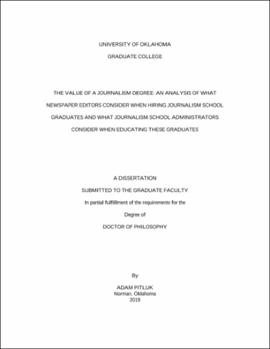| dc.contributor.advisor | Beliveau, Ralph | |
| dc.contributor.author | Pitluk, Adam | |
| dc.date.accessioned | 2019-05-07T20:22:45Z | |
| dc.date.available | 2019-05-07T20:22:45Z | |
| dc.date.issued | 2019-05-10 | |
| dc.identifier.uri | https://hdl.handle.net/11244/319581 | |
| dc.description.abstract | Journalism schools have seen their enrollment numbers ebb and flow for decades though never more so than in the late 20th and early 21st centuries. After the Internet became a serious mode of news delivery, the face of journalism and mass communication changed forever. Perhaps nowhere else have the repercussions of the Internet revolution been more evident than in the still-evolving 21st century legacy newspaper newsroom. The legacy newspaper industry, long populated by journalism school graduates who were promoted through the ranks from reporter-to-editor, saw shifting demands and requirements that affected their need for new hires in terms of both numbers and desired qualifications as circulation numbers and net revenue shifted. While newsrooms continue to shrink, both experienced and newly acquired personnel are required to fill in the gaps to produce sufficient digital and printed copy while management wrestles with the role of the legacy newspaper in the 21st century digital age. Similarly, journalism schools continue to adapt their curricula and implement program changes of their own to stay current and viable in a time populated by readers who are now accustomed to the term “fake news.” The journalism academic administrators tasked with the charge of creating and maintaining conversant curricula must stay ahead of industry trends and ensure that what is being taught is both fresh and appropriate to the demands of the media world.
This study analyzes and interprets the information obtained from in-depth interviews of legacy newspaper hiring editors and journalism academic administrators in order to identify the intersection of industry wants and institutional pedagogy. This research also explores the existing relationship between the two groups. The results point to an intersection of industry wants and academy teachings, and they also highlight a real and perceived disconnect between hiring editors and journalism academic administrators.
Keywords: academic administration, education, journalism, journalism school graduates, media management, newspapers | en_US |
| dc.language | en_US | en_US |
| dc.rights | Attribution-NoDerivatives 4.0 International | * |
| dc.rights.uri | https://creativecommons.org/licenses/by-nd/4.0/ | * |
| dc.subject | Journalism | en_US |
| dc.subject | Newspaper | en_US |
| dc.subject | Education | en_US |
| dc.subject | Administration | en_US |
| dc.title | THE VALUE OF A JOURNALISM DEGREE: AN ANALYSIS OF WHAT NEWSPAPER EDITORS CONSIDER WHEN HIRING JOURNALISM SCHOOL GRADUATES AND WHAT JOURNALISM SCHOOL ADMINISTRATORS CONSIDER WHEN EDUCATING THESE GRADUATES | en_US |
| dc.contributor.committeeMember | Evans, Mary Anna | |
| dc.contributor.committeeMember | Heddy, Benjamin | |
| dc.contributor.committeeMember | Schmeltzer, John | |
| dc.contributor.committeeMember | Steyn, Elanie | |
| dc.date.manuscript | 2019-05-07 | |
| dc.thesis.degree | Ph.D. | en_US |
| ou.group | Gaylord College of Journalism and Mass Communication | en_US |
| shareok.nativefileaccess | restricted | en_US |

